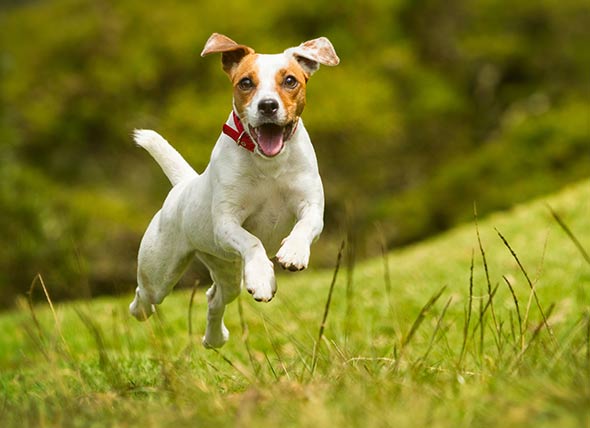Many pet parents are quick to call their high-energy dog “hyperactive,” but is that a fair assessment of the dog’s behavior? Is an over-the-top drive actually abnormal?
According to Clinical Behavioral Medicine for Small Animals (Karen Overall, 2005), true hyperactivity in dogs is actually rare. The hallmarks of hyperactivity—like the inability to fully relax even in familiar environments, reactivity to routine stimuli, a short attention span, and physiological signs like elevated baseline respiration and heart rates—probably aren’t present in the typical overactive dog.
It’s more likely that your high energy dog isn’t having his physical, mental, and social needs met on a daily basis. Dogs who have a hard time settling down might be operating under the influence of many factors, like breed drive, a lack of the right kind of stimulation, or a poor diet. Parenting this type of active dog can feel like a full time job, but there is hope for household peace!
The following multi-level approach will help to address your high energy dog’s needs from the inside out.
WORK THE BODY
First, consider your dog’s exercise requirements versus what he’s actually getting on a daily basis. If you have a high-drive dog from the sporting or herding groups (picture a Border Collie), or even a mixed breed dog who seems to exhibit those same “can’t slow down” tendencies, your dog is going to need a new workout plan and a coach to go with it—that’s you!
There is no universal canine exercise standard, but it’s a safe assumption that if your dog is in constant motion and unable to settle down even at the end of the day, he probably needs more exercise than he’s getting. You can vent some of that excess energy by playing focused games with your dog, like tug and fetch. Both games are excellent energy burners, and when they are played with rules they are transformed into mini training exercises.
If you want to ramp up the play, consider getting your dog involved in dog sports like agility or lure coursing, which are bound to exhaust even the most tireless pooches. And if your dog enjoys the company of other dogs, visit a well-run dog park for some positive social interaction with his peers.
WORK THE BRAIN
Taxing your dog’s body will help to calm him down, but there’s an equally important body part that needs to be exercised: your dog’s brain.
Mental exercise is a phenomenal way to wear out the dog who doesn’t require an all-day commitment or a national park-sized yard. Dogs are athletes, so it’s not always easy to exercise them to the point of exhaustion, but it’s surprisingly easy to work their brains until they’re begging for a break. Something as simple as a shaping game with the clicker (shaping involves breaking down a desired behavior into its incremental parts), which encourages your dog to think creatively and try new things, or teaching him a silly new trick like roll over will require your dog to focus and work through frustration. This isn’t always easy for busy dogs!
Games that incorporate nose work, like “find it,” also force a dog to tap into his senses in a new and challenging way. Finally, treat dispensing puzzle games that make your dog work for his food will turn meal times into brain-teaser times.
INSTILL MANNERS
A dog who jumps all over you when you try to clip on his leash at walk time, constantly nose bops you for attention, and barks at you when he wants his dinner might seem hyperactive, but these inappropriate behaviors actually signal a lack of manners rather than a problem with hyperactivity. Manners training will teach your dog how to engage with you so that he gets what he wants— whether that’s food, attention, play, or access to the outdoors—in a way that incorporates impulse control, which is often the missing link in seemingly hyperactive dogs.
The core concept in manner’s training is teaching your dog to say “please” by sitting for anything he wants. Before you throw the ball, open the door, clip on the leash, or put down the food bowl, first ask your dog to sit. The moment your dog does it, reward him with what he wants, no extra treat necessary. Your dog will soon understand that “sit” makes good things happen, and with consistency on your part (meaning, you always remember to require the sit before doing something for your dog) he’ll begin to offer the position instead of acting pushy with you.
REWARD FOR CALM BEHAVIOR
It’s tempting to tiptoe around when an over-the-top dog finally decides to rest, but it’s important to acknowledge those moments when he’s acting appropriately and taking it easy. Some dogs learn that we only interact with them when they’re engaging in “naughty” behaviors, so they knock over the garbage can and steal laundry in order to get our attention, even if it’s angry attention.
Taking the time to connect positively with your dog when he’s calm, like when he’s resting in his bed or hanging out quietly near you, will encourage him to perform that behavior more often. Remember, behavior that is rewarded will be repeated! Acknowledging your dog’s appropriate behavior with quiet praise and a gentle pat will help him understand that when he settles down he receives positive attention from you. This small change in your daily interactions with your dog can reap surprisingly big rewards.
CONSIDER THE FOOD
It’s tempting to pick up a giant bag of cheap dog food at the local big box store, but what your dog eats can have a direct impact on his behavior.
Inexpensive foods are typically loaded with ingredients that your dog doesn’t need, like fillers, byproducts, coloring, and sugar. Much like eating junk food can alter our moods, feeding your dog a low quality diet can impact his behavior.
Studies have drawn loose correlations between hyperactivity and certain dog food ingredients, so it makes sense to feed your dog a high quality food with pure, easy to identify ingredients, like identifiable meats (no meat byproducts) and minimal fillers and preservatives.
WHEN IS IT TIME FOR A MEDICAL EVALUATION?
Some underlying medical conditions, like metabolic disease associated with liver dysfunction, hyperthyroidism, and neurological conditions, can manifest as hyperactivity (Overall, 2005). If you’re concerned about your dog’s activity level, or if you’ve noticed a sudden change in his behavior, talk to your veterinarian and pursue a diagnostic workup.
This article was verified and edited for accuracy by Dr. Jennifer Coates, DVM.
Do you know which commands are absolutely essential for your dog’s safety? Critical Commands to Save Your Dog’s Life
The following post is by Victoria Schade
For more blog posts please visit https://www.theluckypup.com/blog/
Loving Care You Can Trust!



